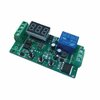The traditional approach is a clock source - to two BCD presettable up/down counters - to two display decoder/drivers - to two 7-segment LED displays.
The clock source can be a simple 1-gate oscillator that you adjust to get close to 1 Hz, or something derived from a crystal or the powerline.
The counters are hard wired in the down-count mode, with "30" hard-wired into the preset inputs. Note that if the initial display is "30", and changes to "29 one second after the button is pressed (which is what most people expect), then "00" is the 31st count. Just sayin ...
Depending on how large/bright you want the display to be, a CMOS decoder-driver might not be able to supply enough current. In that case, you separate the decoding and driving functions into two chips for each digit.
You also need a couple of gates for the control functions.
Looks like 5 chips minimum, 9 max., plus the two digit display.
An alternative is microcontroller - to a 2-digit display driver peripheral chip - to two 7-segment LED displays. Fewer parts, lower cost, more complex, firmware development and debugging ...
What power sources are available?
How big/bright are the displays?
Is the system every going to run on batteries?
Outdoors / harsh / rugged environment?
ak



